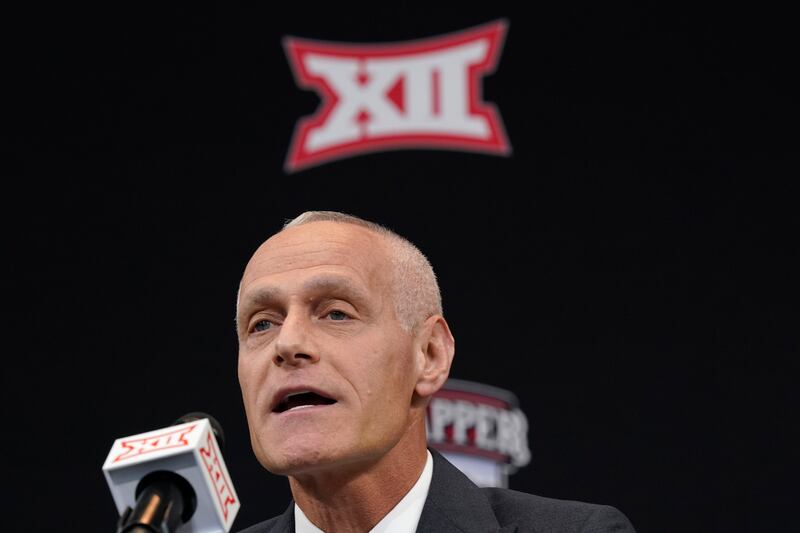The Big 12 might be looking to expand sooner rather than later.
And this is causing some folks heartburn and anxiety on one hand and giddy celebration on the other. Break out the popcorn, this is entertaining.
According to CBS Sports college football editor Dennis Dodd, Big 12 commissioner Brett Yormark expedited the departure date of Oklahoma and Texas from the Big 12. Now that that’s out of the way, he likely will look to the Pacific time zone for anywhere from two to four teams.
That job may have become easier with word out of recent Pac-12 meetings in Tempe that the solidarity of presidents in that league may be cracking. Multiple sources are saying that ASU is not happy with how media rights negotiations are going. Rumored additions of Southern Methodist and San Diego State have met mixed reviews.
Pac-12 commissioner George Kliavkoff visited SMU this past week according to Brett McMurphy and he secretly visited SDSU in December. Reportedly, potential media partner Amazon asked the Pac-12 to add inventory (expand) ahead of when a new deal is set to be signed. In this plan, more than half of the Pac-12 football games would be aired on streaming platforms instead of traditional networks and cable outlets.
According to Stewart Mandel of The Athletic, the Pac-12 is in dire need of action.
Kliavkoff has overpromised and undelivered on media rights money.
This leading from behind by the Pac-12 is drawing warnings from the national media.
USA Today’s Dan Wolken tweeted, “If I’m the four corners schools, I’m running to the Big 12 as fast as I can (if they’d have me).”
The “four corners” schools of the Pac-12 are ASU, Arizona, Colorado and Utah.
But in a recent column by Oregon-based Pac-12 columnist John Conzaano, former Fox Sports executive Bob Thompson ranked the value of the 10 remaining Pac-12 teams. Using a formula based on market size, TV households, football brand, win percentage, Olympic sports, fan support and basketball impact, Thompson put Washington No. 1 followed by Oregon, Stanford and ASU.
That leaves the question if the Big 12 grabbed Pac-12 teams, would it make a move for the four corners schools or go for value, generally accepted as Washington and Oregon as the most valued brands?
The Big Ten is no longer interested in expanding so UW and Oregon are not going to get that call as chatted about last summer during media day football meetings.
If ASU and Arizona bolted, would it have to be a package deal? What about Utah in that scenario? Would the Big 12 take two teams from the same small Salt Lake City market?
Until something concrete happens, it’s the candid and sometimes comical chatter that is dominating social media as fan bases get involved in passing around opinions like Super Bowl chips and dip.
Sensing an impending shift, a Utah fan threw out a scenario where Utah would be invited to a giant football league and BYU would be left out.
A fan in the Midwest throws out a priority expansion menu:
Holding onto the vision that the Pac-12 be involved in some creation of a mega-conference, a fan of Arizona @tucsontwitchy tweeted, “What I think they should do is blow up both conferences and pick the best value 16 to 20 for a new mega conference and just leave the remaining schools with limited football/basketball value to run to smaller conferences.”
Then there’s the defense of adding SMU and SDSU to the Pac-12 — lifelines are lifelines:
Then a BYU fan responds:
And a Utah fan examines reality:
Then a BYU fan, remembering how Texas and Oklahoma joined USC and UCLA who big-timed their conference, tweets:
Then comes Marc Londo, who put Kliavkoff’s situation in perspective with history and what transpired when Mike Aresco, commissioner of the Big East, woke up one day and his conference was gone. Drip, drip, drip.
A Ute fan sees an optimistic future in academic associations and Pac-12 tradition can only flourish in days to come:
Bottom line?
The alliance and solidarity of Pac-12 chancellors and presidents has been impressive since news that USC and UCLA were departing for the Big Ten. It was a good move to ask for unity as Kliavkoff negotiates a new media deal.
But Yormark’s strategy to jump the gun and get a deal with ESPN and Fox in place ahead of the Big 12 contract expiration date was a brilliant move and has provided a baseline for what the Pac-12 schools should shoot for.
If an expanded Pac-12 can garner an equitable money amount, that would be fabulous for the remaining schools, Utah in particular.
Another alternative out there is for the Pac-12 to try to poach a team from the Big 12, but that doesn’t seem to be gaining any traction in the Midwest. Right now the Big 12 brand is sending off vibes of stability and profitability.
It appears Kliavkoff and Amazon and the idea of going the streaming route could be forward-looking and futuristic. But it could also cost in the short run. Kliavkoff is asking Pac- 12 leaders to sacrifice visibility for money and security.
It isn’t an accident that Yormark got Texas and Oklahoma to exit earlier than expected, making a deal to satisfy the Big 12 networks and legacy eight programs. It is also a fact he said he would “aggressively” look to expand the Big 12 footprint and going west made the most sense.
For the Pac-12’s four corners schools, accepting a call from Yormark, just for the sake of discovery, seems prudent if not a must.
It will make for an interesting spring.



